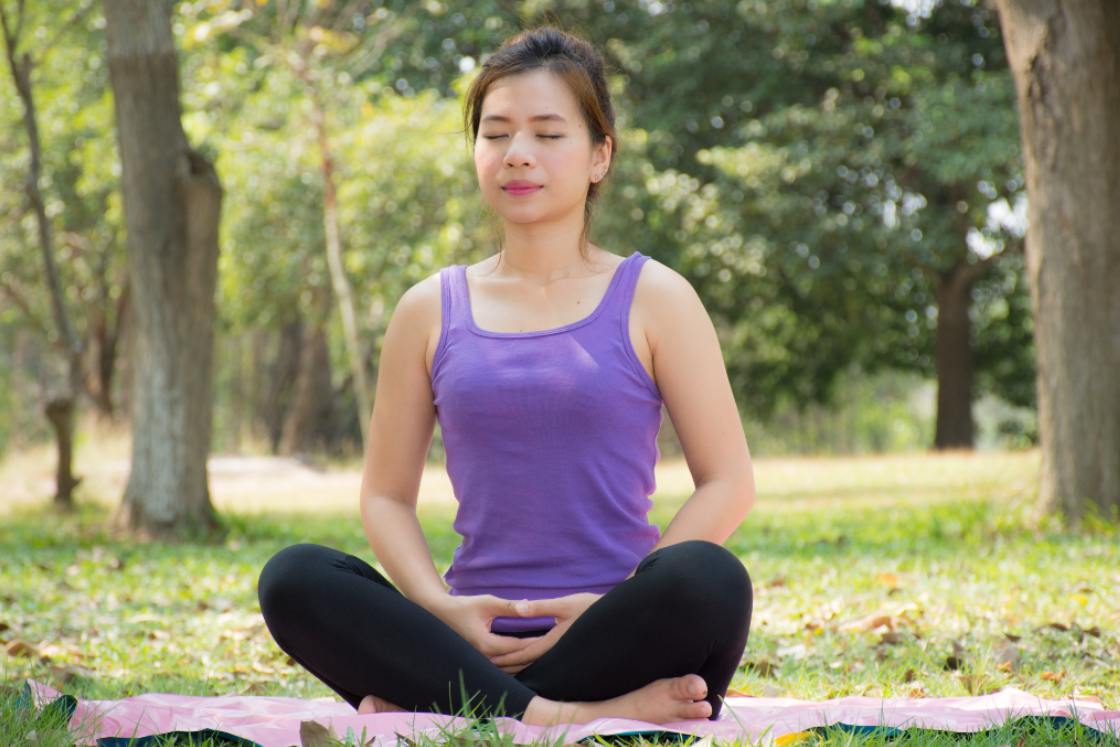
Image Source: Shutterstock
Holding the breath for a natural period up to 30 seconds is a relaxation mechanism of the body. But if you can increase this natural period of holding breath, it can benefit a lot.
In yogic breathing, sama vritti pranayama is one such technique that let us consciously incorporate longer breath retention in our natural breathing process.
Incorporating conscious breath retention in the natural breathing process increases the lung capacity & life span. So let’s learn more about this breathing technique called Sama vritti Pranayama.
Sama Vritti Pranayama or The Box Breathing
Sama is a Sanskrit term has literal meaning “Equal” & Vritti means “Flow” or “Wave” (This vritti is different from Yoga Chitta Vritti Nirodha). Equal denotes here “the duration” & Vritti denotes “Movement of breath”.
In the Sama Vritti breathing technique, we try to equalize the duration of each breath movement that we breathe in & out through nostrils. To understand it more clearly, we can divide our breath into 4 basic parts:
- Inhalation (Puraka)
- Breath retention after inhalation (Antar kumbhaka)
- Exhalation (Rechaka)
- Breath retention after exhalation (Bahya kumbhaka)
(1→2→3→4) This is the natural cycle of our breathing but how many times we consciously pay attention to the 2nd & 4th point as well on the duration of each part? Probably a very few times, isn’t it?
Sama vritti pranayama is specially designed to regulate equal breathing habit in a person so our respiratory system work without any strain. It’s also called the box & square breathing as its representation becomes easy using a square box.
Why Sama Vritti Breathing Is Important?
- It has been observed Sama vritti pranayama is a type of slow & deep breathing exercise when performed accurately. Any breathing technique which is slow & deep has a stress-busting effect & thus regulates the autonomic nervous system (ANS).
- If you have ever seen a person taking small naps instead of long sleeping & you want the same, the Sama vritti pranayama technique is good for you. This breathing technique is used by U.S. Navy SEALs to reduce stress response & thus reduces the sleep time.
- The regular practice of Sama Vritti Pranayama makes us aware of every moment of the breathing cycle. This awareness doesn’t let mind fickle on other thoughts & hence a good preparatory exercise for meditation.
Get Started with Sama Vritti Pranayama
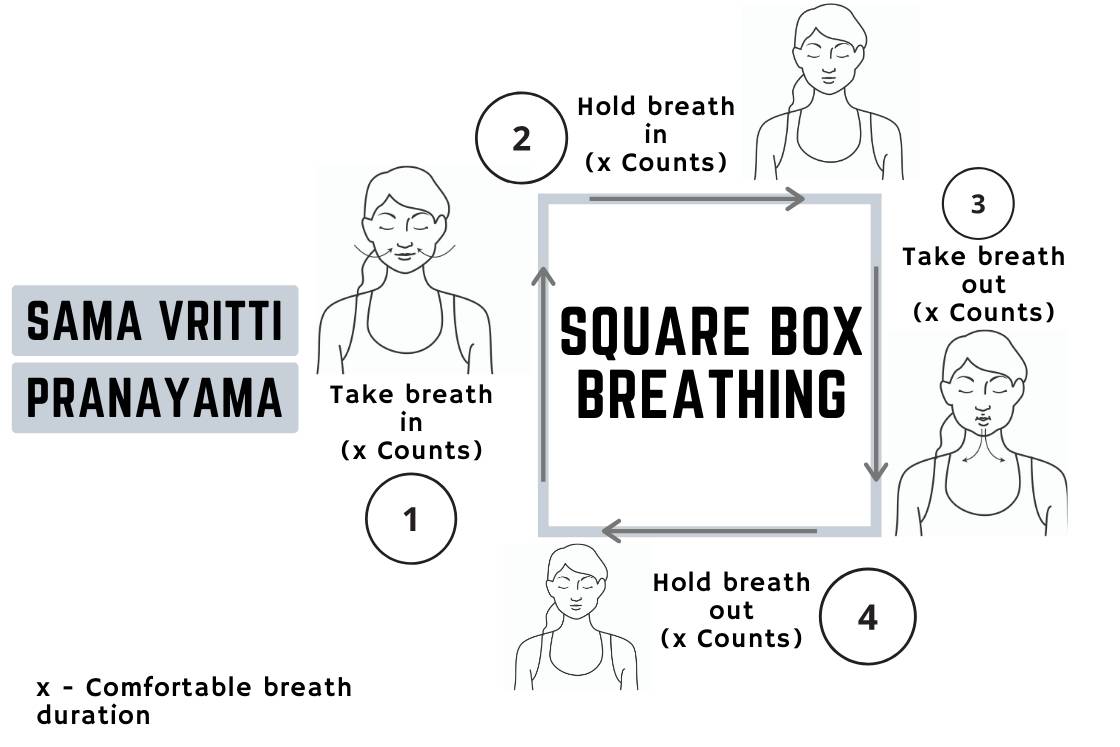
© Fitsri
Before you get started sama vritti pranayama, make sure you’re seated upright on the floor or if not comfortable on the floor, a chair can be considered.
Come in any cross-legged meditative posture like easy pose, elevate your hips level with some bolster or thick pillow & place your hands in Gyan mudra over kneecaps. This elevation will give your spine a perfect elevation & also let our Prana flow obstacle-free.
When you’re ready, start with step 1.
Step-by-step Instructions
Step 1: Slowly Inhale
Start with simple & deep breathing. Inhale as you usually breathe in & count (mentally) the inhalation period for 4 counts (1…2…3…4).
Step 2: Hold the Breath In
At the top of the inhalation, hold the breath in for same duration of 4 counts. Keep counting duration mentally & make sure your awareness is attached with your breath flow.
Step 3: Slowly Exhale
On the last count of holding, start exhaling the held breath slowly out & empty the lungs from the air you inhaled in the first step. Again, keep mentally counting the duration of exhaling for 4 counts.
Step 4: Hold the Breath Out
At the top of exhalation, pause your breath out again for 4 counts. Here hold your wondering mind with the breath for the same counts.
It’s the end one cycle of Sama vritti pranayama. Continue in the same manner for 7-8 cycles & feel the calmness it brings in mind.
Tips for Sama Vritti Technique
- In the beginning, if you’re not comfortable holding the breath for equal counts then practice it without breath retention. Inhale for “x” counts then simply exhale for same “x” counts. “x” counts you can choose as per your comfortability.
- You can place one hand on the chest & other on the lower abdomen to feel the filling & emptying while any deep breathing exercise. It’ll help you to become more conscious of your breathing.
Benefits of Samavritti Pranayama
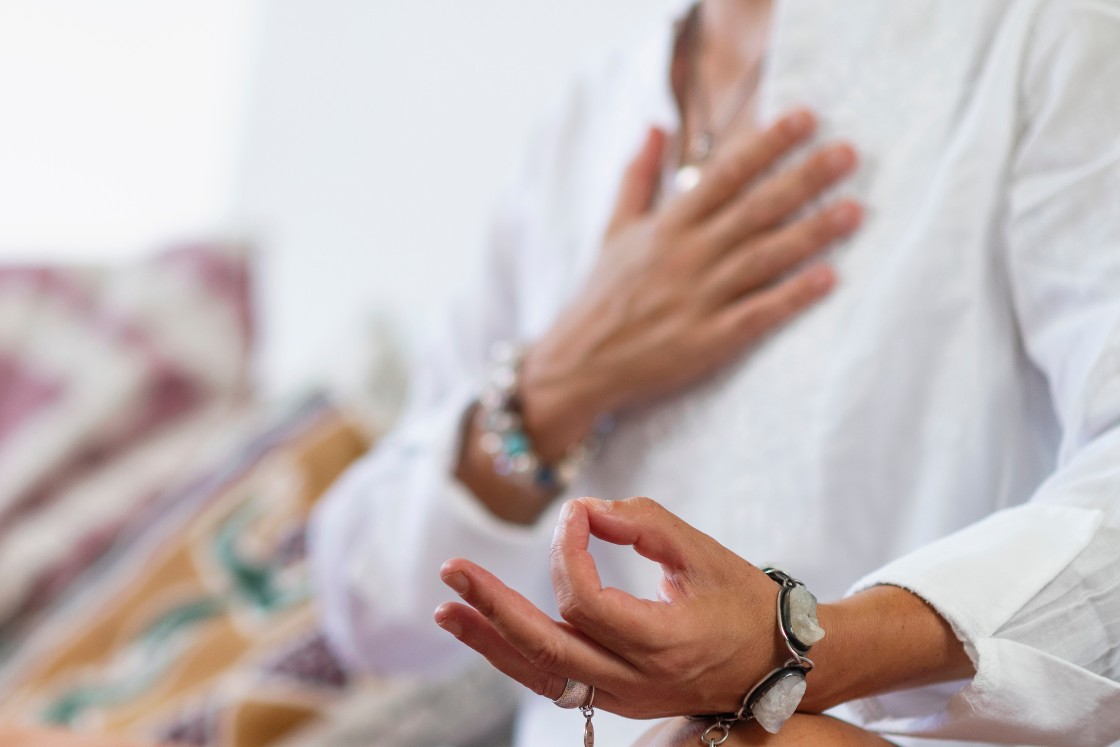
Image Source: Shutterstock
In Yoga, Prana is different from the breath we take. Prana is a flow of energy that regulates all the organs of the body.
Let’s see how it works with Sama Vritti Pranayama:
1. At the time of Inhalation (Puraka)
In Sama vritti, while we taking a breath in, prana at a subtle level fills life force in every cell of the body. Here’s how it benefits physically:
- Conscious inhalation of equal duration helps to improve the capacity of the lungs.
- It helps to energize the sleeping cells of the body.
- Long and deep inhalation (Puraka) build strong awareness.
2. At the time of retention After Inhalation (Antar Kumbhaka)
When we become comfortable in holding the breath for equal counts for a few rounds:
- We actually tell our Prana to stay in a state of calmness.
- When Prana consciously held inside the body for equal counts its capacity to charge other organs increased automatically.
- It distributes the energy equally to all the organs of the body.
- Cause of Antar Kumbhaka, Prana moves upwards which leads to awakening the Kundalini and hence it reaches the position of the crown chakra.
3. At the time of Exhalation (Rechaka)
- It helps to detoxify the body and release all the toxins out of the body.
- Exhaling breath helps to reduce stress and anxiety.
- Equal duration of exhalation in Sama vritti pranayama makes the Diaphragm active.
- It helps to maintain a better immune system.
2. At the time of Retention After Exhalation (Bahya Kumbhaka)
The act of retaining or holding of breath just after a long exhalation is Bahya Kumbhaka. This part of breathing has the following benefits:
- When there is no prana moving inside your body, it makes the body come in a silent position automatically.
- This silence is helpful to calm the mind Psychologically and physiologically.
- Prana moves from the base of the spine upward to the brain. When there is no inhalation or exhalation – the root of the spine or the place of root chakra also becomes calms. It removes the sense of attachment from the mundane world.
- This part of breathing helps in meditation.
Precautions & Contraindications
As Sama Vritti Pranayama is the only Pranayama which contains holding of breath twice in a practice, some precautions & contraindications are listed below:
- Pregnant Women: Avoid holding breath. The exhales and inhales shouldn’t be deep as in pregnant women Diaphragm can not adjust with the fetus.
- Blood Pressure: In case of HBP, one can also skip the retention of breath.
- Don’t Strain while Kumbhaka: The retention of breath after exhalation & inhalation should not produce any strain on respiratory organs.
- Trauma-Sensitive: Avoid external retention of breath as lungs and the diaphragm may feel tight when practicing Bahya Kumbhaka. Therefore it is best to avoid the practice of Sama Vritti completely by those suffering from trauma as they will feel uneasy.
Vishma Vritti vs. Sama Vritti
Once you become a master in Sama vritti Pranayama, then next comes is Vishma Vritti pranayama.
In Vishma vritti, the duration of inhalation vs. exhalation is unequal. In Vishma vritti:
- If inhalation is longer than exhalation, it’s considered energizing pranayama.
- On the other hand, if the exhalation is longer than inhalation, it’s considered relaxing pranayama.
The common ratio of breathing in Vishma vritti pranayama is 1:4:2:1. This means (inhalation for 4 seconds, retention for 16 seconds, exhalation for 8 seconds, and retention after exhalation for 4 seconds.
While in Sama vritti pranayama, we follow 1:1:1:1 breathing ratio.
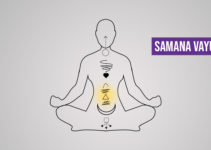
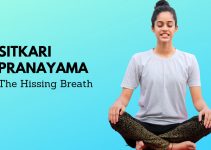



What is one breath you would recommend for trauma sensitive?
Anulom Vilom – it’s a balancing breathing exercise very useful to reduce anxiety and calm the mind. Apart from this, abdominal breathing in the supine position is also useful.
Is an empty stomach condition necessary for doing this pranayam?
In general, all yogic practices are said to do with an empty stomach, sama vritti pranayama is no expectation! Because it uses diaphragmatic breathing; you want to keep your stomach as empty as possible to ease abdomen movement. However, you can choose to have light food if there is enough gap between your meal time and yoga practice. Here’s an article for your reference on what you can eat (and when) before yoga practice!